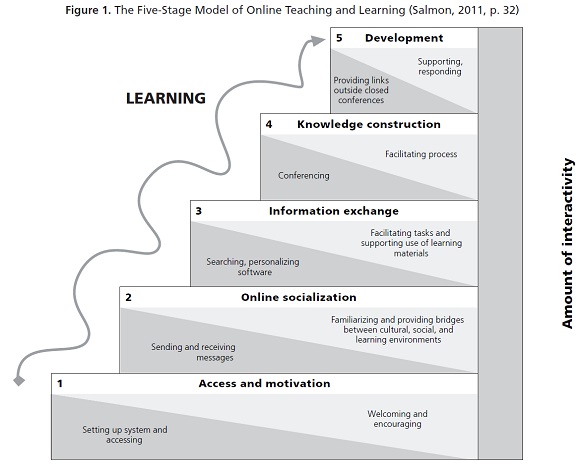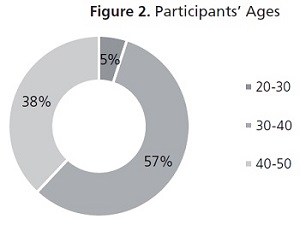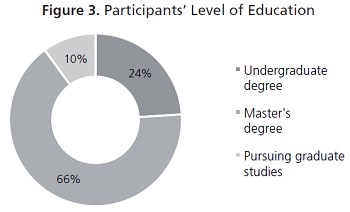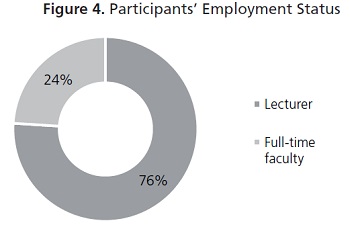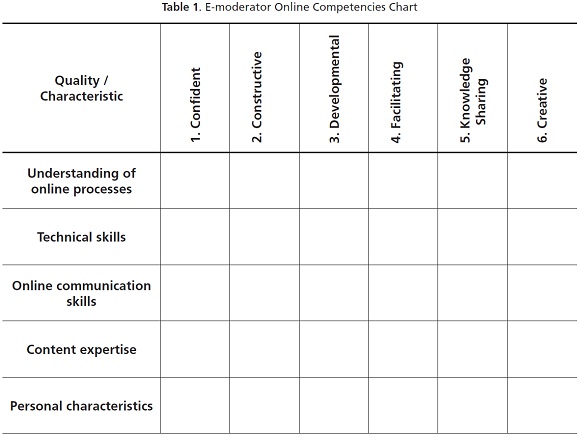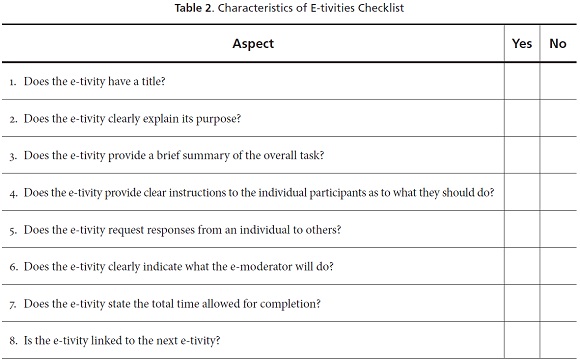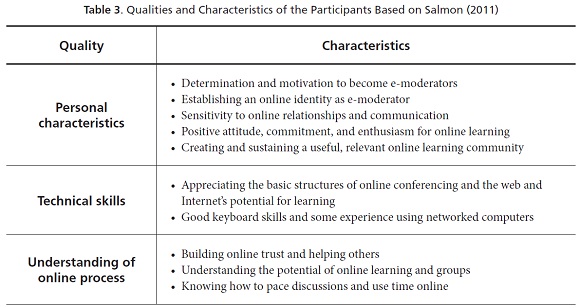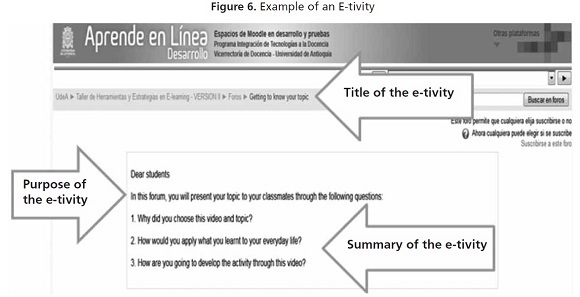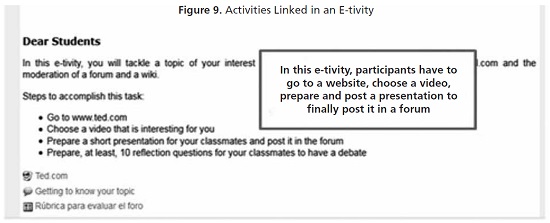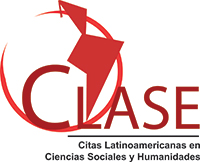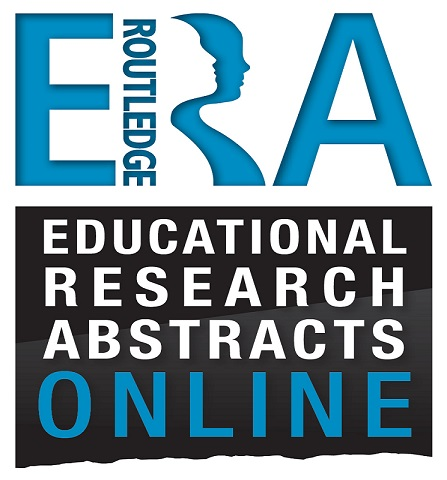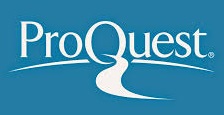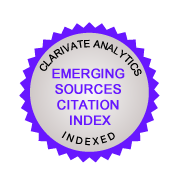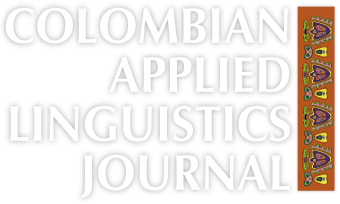
Published
E-moderating and E-tivities: The Implementation of a Workshop to Develop Online Teaching Skills in In-service Teachers
E-moderación y e-actividades: implementación de un taller para desarrollar habilidades de enseñanza en línea de profesores en ejercicio
DOI:
https://doi.org/10.15446/profile.v18n1.44269Keywords:
E-moderation, e-moderator, e-tivity, foreign language teaching, higher education, online course, teacher’s professional development (en)curso virtual, desarrollo profesional docente, e-actividades, educación superior, e-moderación, e-moderador, enseñanza de lenguas extranjeras (es)
This paper reports the experience of implementing a teacher’s professional development strategy that sought to foster e-moderator competencies among language faculty at a Colombian public university. The study aimed at finding the extent to which participants understood the concepts of e-moderation and e-tivities. We analyzed the participants’ performance in three different tasks to give account of the incorporation of the concepts. The results from the analysis of the tasks showed that participants understand online processes, they have some technical skills and they have many personal characteristics that will help them become e-moderators.
https://doi.org/10.15446/profile.v18n1.44269
E-moderating and E-tivities: The Implementation of a Workshop to Develop Online Teaching Skills in In-service Teachers
E-moderación y e-actividades: implementación de un taller para desarrollar habilidades de enseñanza en línea de profesores en ejercicio
Jorge Eduardo Pineda Hoyos*
Luis Hernando Tamayo Cano**
Universidad de Antioquia, Medellín, Colombia
*eduardo.pineda@udea.edu.co
**lhernando.tamayo@udea.edu.co
This article was received on July 4, 2014, and accepted on July 28, 2015.
How to cite this article (APA 6th ed.):
Pineda Hoyos, J. E., & Tamayo Cano, L. H. (2016). E-moderating and e-tivities: The implementation of a workshop to develop online teaching skills in in-service teachers. PROFILE Issues in Teachers' Professional Development, 18(1), 97-114. https://doi.org/10.15446/profile.v18n1.44269.
This is an Open Access article distributed under the terms of the Creative Commons license Attribution-NonCommercial-NoDerivatives 4.0 International License. Consultation is possible at http://creativecommons.org/licenses/by-nc-nd/4.0/.
This paper reports the experience of implementing a teacher’s professional development strategy that sought to foster e-moderator competencies among language faculty at a Colombian public university. The study aimed at finding the extent to which participants understood the concepts of e-moderation and e-tivities. We analyzed the participants’ performance in three different tasks to give account of the incorporation of the concepts. The results from the analysis of the tasks showed that participants understand online processes, they have some technical skills and they have many personal characteristics that will help them become e-moderators.
Key words: E-moderation, e-moderator, e-tivity, foreign language teaching, higher education, online course, teacher’s professional development.
En este artículo se reporta la experiencia de implementación de una estrategia de desarrollo profesional docente que tuvo como objetivo la adquisición de competencias en moderación en ambientes virtuales de aprendizaje de profesores de lengua extranjera en una universidad pública colombiana. Se buscó identificar hasta qué punto los participantes en el curso incorporaron los conceptos de e-moderación y de e-actividad en su repertorio pedagógico por lo que se analizó el desempeño de los participantes en tres tareas diferentes. Los resultados muestran que los participantes comprenden los procesos de educación en línea, poseen habilidades técnicas básicas y tienen características personales que les ayudarán a convertirse en e-moderadores.
Palabras clave: curso virtual, desarrollo profesional docente, e-actividades, educación superior, e-moderación, e-moderador, enseñanza de lenguas extranjeras.
Introduction
Online education and technology-enhanced learning are becoming important issues for higher education programs and language education is no exception. Higher education institutions should think about offering faculty professional development programs to develop skills that would help them cope with “the pressures of adapting their current teaching ideologies and practice to align with rapidly expanding digital tools and expectations for learning and teaching” (Salmon & Wright, 2014, p. 53). These professional development programs should help faculty develop skills to cope with students’ challenging abilities to engage in more informal learning opportunities outside the classroom. However, higher education institutions offer faculty opportunities to develop those skills usually as workshops that favor a technological exploration of certain tools, but neglect their pedagogical use (Daniel, 2012; Herman, 2012; Macdonald & Poniatowska, 2011; Salmon & Wright, 2014). In addition, faculty shows some resistance as regards attending training workshops because they usually represent increasing academic responsibilities and inadequate time allowance and incentives (Allen, Seaman, Lederman, & Jaschik, 2012; McQuiggan, 2012).
Teachers in our institution have several needs regarding the development of moderation skills and the design of online language activities since when teaching online, they are more concerned about assigning grades than promoting interaction or designing new activities for their courses. To respond to the needs of our language faculty, we designed a professional development strategy that helps them develop the skills to deal with the new challenges they face when trying to embed technology into their teaching. The program focuses not only on the instrumental use of the tools, such as setting up a blog; it also focuses on its pedagogical use. For example, reflecting on the ways to use a blog to teach a concept or to develop a skill such as identifying the main idea of a text. Our professional development program takes participants from a techno-centric focus to a knowledge-centric focus and seeks to be a successful, outcome-driven professional development opportunity exploring the process participants undertake to develop the skills necessary to teach in online and blended learning environments, also called e-moderation competencies (Figg & Jaipal, 2012; Macdonald & Poniatowska, 2011; Salmon, 2011).
Literature Review
The course was designed based on two concepts: e-moderation and e-tivities. In this section of the paper, we will go through some experiences in which the concepts of e-moderation and e-tivites are part of a professional development program and we will examine those concepts.
Although there are many studies regarding the deployment of professional development programs in higher education, the experiences regarding the implementation of professional development programs focusing on the concepts of e-moderation and e-tivities are not very numerous; the experiences we found report the existence of collaborative, team-based, online learning designs with different purposes such as (1) helping faculty at campus-based universities introduce and deploy a new learning management system (LMS) and (2) moving from a single professor taking responsibility for a unit or a course to a team approach or (3) establishing an effective process for the development of contextualized knowledge and skills in online teaching in order to enhance student learning outcomes (Gregory & Salmon, 2013; Salmon & Wright, 2014; Salmon, Gregory, Dona, & Ross, 2014). The implementation of professional development programs based on the concepts of e-moderation and e-tivities have “proven suitable for the design of brand new courses and for transforming face-to-face, campus-based courses into online or blended versions” (Salmon & Wright, 2014, p. 55) as well as to provide an effective professional development route for larger numbers of staff (Salmon et al., 2014; Salmon & Wright, 2014). Finally, Shin and Bickel (2012) report that in order to have successful professional development strategies or programs, training needs to be aligned with the trainees’ needs so participants perceive training as something positive for their professional practice.
E-moderation
E-moderation is a term coined by Salmon (2011) that refers to processes of managing the communication among teachers and students in online environments and the skills online teachers or e-moderators employ to establish a teacher’s presence in an online environment. Salmon (2011) developed a model for appropriately moderating an online course (see Figure 1).
Salmon (2011) summarizes her model as follows:
At stage 1 individual access and the ability of participants to use online learning are essential for group learning to develop. Stage 2 involves individual participants establishing their online identities and finding others with whom to interact. At stage 3, participants give each other information relevant to the course. This stage is characterized by cooperation and support for each person’s goals. At stage 4, group discussions start and the interaction becomes more collaborative. At stage 5 participants use the system to achieve their goals, seek to integrate online into other forms of learning and reflect on their learning process. Each stage requires the participants to master certain technical skills, in the bottom left of each step, as well as e-moderating skills, on the right top of each step. The levels of interactivity, shown in the “interactivity bar” that runs along the flight of the steps, also increase and the kind of information and messages that the participants exchange also change through the steps and the stages of the model. (p. 32-33)
This model underlies several assumptions: (1) Online learning goes beyond “undertaking activity on a computer . . . online learning . . . includes . . . interaction between neural, cognitive, motivational, affective, and social processes” (Azevedo, 2012, p. 31). (2) Learning is a process where transformation takes place in leaps and bounds and (3) participants in an online setting learn about working online along with learning about the topic with, and through other people. Success of online learning depends on the appropriate integration of learning about technologies and learning through or with technologies (Macdonald, 2004). The model seeks to promote the interaction between groups of peers and the e-moderator who plays the role of mediator and supporter (Berge, 2007). The implementation of the model to design courses has benefits for designers, e-moderators, and participants. Designers know how participants are likely to exploit the system at each stage, e-moderators enjoy working online and find that their processes run smoothly, and participants feel they can control their own learning by focusing on tasks and processes (Hopson, Simms, & Knezek, 2001; Salmon, 2011).
E-tivities
The term e-tivity refers to the “frameworks for enabling active and participative online learning by individuals and groups” (Salmon, 2013, p. 5). E-tivities have several characteristics: they make the work of the teachers more productive and focused, they are focused on the learners; they transfer the knowledge to the resources and the learners’ skills to access information because they are based on the idea that knowledge is socially constructed; e-tivities are cheap and are easily combined with face-to-face environments (Richards, 2005; Salmon, 2013). Rumble (2010), reflecting on the costs of producing learning materials as an aspect that may hinder innovation in higher education and advocating for the implementation of e-tivities, says that:
Preparing online learning materials is a very expensive business. Few academics or teachers have all the necessary skills, the time and the desire to spend months creating texts and video. There is usually a need to frame the production of material on a project with one or more subject experts, instructional designers and web developers. And sometimes mobile application developers, information specialists and more people are required to produce a single piece of material. E-tivities help saving costs because they use existing resources, are reusable, are adaptable and are based on the participants’ exchange of knowledge. (p. 264)
Herrington, Reeves, and Oliver (2010) suggest that e-tivities promote engagement because they build up robust and usable knowledge through authentic tasks and situations. Laurillard and Scharmer (as cited in Salmon, 2013), characterize e-tivities as a way of accessing and digitally applying teachers’ creativity, vision, and inspiration.
Method
This study is a single instrumental case study with a holistic and interpretative approach to data analysis. It is single instrumental because it focuses on a specific issue; it uses a holistic and interpretative approach to analyze the data because the entire case is examined and descriptions, themes, and interpretations related to the case are presented (Creswell, 2007; Merriam, 1998; Stake, 1995; Yin, 2003). We followed a case study as a research approach because it allowed us to explore and analyze the course to answer the following research questions: (1) What e-moderator competencies from the ones proposed by Salmon’s (2011) model of online learning and teaching are identified in the forum discussion in the course? (2) What characteristics from the ones proposed by Salmon (2002, 2013) are identified in the e-tivities designed by the participants in the course? (3) What are the strategies and activities that the participants of the course display for each stage of Salmon’s (2011) model of online learning and teaching in an online course?
Course Description
In this section of the paper, we will provide a description of the course used as a professional development strategy. The course has been offered twice (2013, 2014) and had a 32-hour intensity. The first time in a blended modality with 10 hours of face-to-face meetings and the other 22 hours were used for asynchronous work such as forum participation and preparation of e-tivities and readings and the second time completely online.
The course runs on the Moodle platform and has five Units. Unit 0 is an introductory unit containing a welcome message, the methodology, the content, the course timetable, the assessment, two forums, the references used in the course, and the course and teachers’ evaluation. Unit 1 explores the concepts of e-moderation and e-tivity. It has a video about the reasons to include technology in the classrooms and readings and presentations that explore the main concepts of the course. Unit 2 explores internal-to-Moodle resources. It contains video tutorials on how to set up a questionnaire, a chat room, an assignment, a forum discussion, a sample and a tutorial to design a rubric to assess a forum discussion. Unit 3 explores external-to-Moodle resources. The unit presents video tutorials of different resources for teaching reading and listening, a video about the advantages of using an LMS or the open web as a learning platform. The final unit of the course embodies the assessment, where participants have to design and upload an e-tivity.
Participants
There were 20 participants in this study, 14 teachers from the first version of the course and six teachers from the second version. None of the participants had any prior experience working with e-tivities or with the concept of e-moderation, but most of them had previously worked with the Moodle platform at least once in their academic or professional life. See Figures 2, 3, and 4 for more information about the characteristics of the participants.
Data Collection Instruments and Analysis
We, as moderators, asked the participants to complete three tasks during the eight weeks that the courses lasted. Participants’ contributions to a forum discussion for Tasks 1 and 3 and an assignment submission for Task 2 were used as data sources in order to obtain qualitative information; the instruments also allowed for some quantitative analysis in terms of frequencies and percentages, which are reported in the results section.
In Task 1, participants had to discuss the principles of e-moderation and the roles and skills of e-moderators; they posted their contributions to a forum discussion that was later collected for analysis. This task was analyzed in light of the e-moderators’ competences outlined by Salmon (2011). There was at least one contribution per participant and the time allowed for completing this task was one week. Table 1 shows the instrument used to analyze this task.
In Task 2, participants had to design an e-tivity. Each participant designed one e-tivity which they published in a space for online assignments submission in the platform and the e-tivities were collected at the end of each course. This task was analyzed using a checklist based on the characteristics of e-tivities: title, a clearly explained purpose, a brief summary of the task, clear instructions for the participants, requested responses from an individual to others, instructions for the e-moderator, total time allowed for the completion of the activity, and link to the next activity as described in Table 2.
And, in Task 3, participants had to describe the strategies and activities that could be incorporated in an online course based on Salmon’s (2011) model. There were about 42 posts since each participant had contributed at least twice. This task was analyzed using a three-column chart: The first column contains the stages described in the model (access and motivation, online socialization, information exchange, knowledge construction and development). The second column comprises the strategies in the model (setting up and accessing the system, sending and receiving messages, carrying out activities, reporting and discussing findings, conferencing, course-related discussions, critical thinking applied to subject material, making connections between models and work-based learning experiences, use of conferencing in a strategic way, and reflection on learning process). The third column presents some of the activities or actions that can be carried out in each stage: for example, welcome and encouragement, introductions and icebreakers, assigning roles and responsibilities, asking questions and encouraging discussions and reflection.
Results
This segment of the paper reports the results from the analysis of the tasks assigned to the participants. Results from Task 1 report the e-moderator competencies. Results from the second task report on e-tivity design and the results from the third task give an account of the strategies and activities the participants may implement in an online course based on Salmon’s (2011) model.
Results From Task 1
The results from this task are reported in terms of the competences we identified from the ones proposed by Salmon (2011) and are not intended to make a difference between the competencies that the participants brought to the course and the ones they developed during the course. Also, the results are not intended to make a categorization of the competencies in the blended and the online versions of the course. These results seek to answer the research question: What e-moderator competencies from the ones proposed by Salmon’s (2011) model of online learning and teaching are identified in the forum discussions?
The forum discussions from participants in both versions of the course show several personal characteristics that can help participants develop the necessary skills to become e-moderators. They show determination and motivation to become e-moderators. The following post reflects how the concept of e-moderation helps a participant understand what an online teacher should be:
I hadn’t had the opportunity of studying the concept of e-moderation and now that we have discussed it I think it was what I needed to understand what an online teacher should be. I think I need to continue exploring but you have opened a new topic I really want to learn more about.1 (P8)
They also show a positive attitude, commitment, and enthusiasm for online learning. The following participant’s contribution shows that she is very motivated towards online learning and she harbors a strong desire to be trained in the use of technology in education:
I feel very motivated towards online learning. I believe we all need to be trained in the use of ICT. Computers and technology are here to stay and we, teachers, need to learn how to use them. I really want to continue learning more about online learning and e-moderation. (P11)
Another characteristic participants developed in both versions of the course was to establish an online identity as e-moderators which means creating an online presence by means of a profile picture and a personal e-moderating style that are reflected on writing and message style. All participants built their profiles in the platform with a personal description, a picture, and a brief summary of interests. A sample is presented in Figure 5.
Sensitivity to online relationships and communication is another personal characteristic identified in the participants’ contributions that allow e-moderators to facilitate online processes; it implies providing suitable feedback and using language appropriately (Salmon, 2011). These posts are examples of these characteristics:
E-moderators should pay close attention to the participation of students to give feedback and promote reflection among students. (P4)
When communicating with my students online I take into account that I need to be careful with language and that I need to be very clear to avoid confusion and disorientation. (P11)
Reflecting on the role of different language skills in online learning also shows the participants’ willingness to work in online learning environments. A participant discusses the role of the written language in online settings to give instructions and to promote clarity:
Online settings generate more elaboration, the writing language as a means of interaction is more elaborated. In face-to-face settings it is different because you give instructions and if students don’t understand you simply repeat what you say. In online settings you don’t have those immediate moments to clarify. In online settings students do what they think they have to do according to the instruction. (P18)
Creating and sustaining a useful and relevant online learning community also appeared in the discussions in the forums in both courses. However, this would be an issue to further explore. This post reflects that discussion:
Learning occurs when there is interaction among students, students and online environments, and students and teachers. Therefore, being part of a community or a group is fundamental to learning. (P19)
Regarding technical issues, participants had the basic technical skills and the willingness to be trained as e-moderators such as reasonably good keyboard skills and some experience using networked computers or an LMS (Salmon, 2011). However, they stressed the need to know how to use special features of software to be incorporated in their online lessons.
Participants in both versions of the course seem to be able to build online trust, to help others in online environments and to understand the potential of online learning to support students (Salmon, 2011). Salmon defines those competences as necessary skills prospective e-moderators should have to become e-moderators. The following posts show how participants think online learning helps them find ways of addressing their students’ needs and how they help their students feel confident in their online courses:
Online learning provides new and interactive ways of addressing my students’ needs. (P2)
Understanding the potential of online learning is very important because I can relate to my students and help them feel confident in an online course. (P3)
They also showed other characteristics such as being able to appreciate the basic structures of online conferencing and the web. In this post from a participant, we can see an example of this appreciation:
In web-based environments there are some tools like forums that can be used for discussions of certain topics by debating and explaining reflections. (P4)
Participants in both versions of the course seem to know how to pace discussions and use time online. In this post, a participant explains how he facilitates discussions in his online classes:
I involve my students in the discussions by giving them topics of their interests and giving students time to study them before asking them to post their opinions. (P5)
Table 3 shows a summary of the qualities and the characteristics identified in the forum discussion in Task 1.
Results From Task 2
This section of the paper reports the characteristics of the e-tivities the participants designed. The characteristics of the e-tivities are based on Salmon’s (2002, 2013) e-tivity framework. The results from this task are intended to give account of the characteristics identified in the e-tivities, hence, the results are not intended to provide a deep analysis of the e-tivities designed in each version of the course (blended and fully online). However, we will provide a certain degree of comparison. The results from this task seek to answer the research question: What characteristics from the ones proposed by Salmon (2002, 2013) are identified in the e-tivities designed by the participants in the course?
All of the e-tivities in both versions of the course had a title. Salmon (2002, 2013) states that the title of an e-tivity must entice the student to take part in the activity; plus, it should be very brief and requires creativity from the e-moderator. During the first time the course was offered, 67% of the e-tivities stated their purpose and only 32% of the e-tivities showed this characteristic in the second version of the course. The purpose of an e-tivity allows the students to know what objectives or aims they will achieve or understand better. Salmon (2002, 2013) suggests using verbs and linking the e-tivity with the objectives or outcomes of the unit, module, or course program. Similarly, during the first time the course was offered, 67% of the participants provided a summary of the task while in the second version only 32% of the participants did. Further exploration is required to find out why participants paid more attention to this feature in the first version of the course; we discuss some of the possible reasons in the conclusions of the study. Salmon (2002, 2013) suggests that the summary of the task should be clear: It should contain brief instructions on how to take part in the activity and what to do and she strongly suggests including only one question or task per message. E-tivity design can help students become more motivated to undertake the e-tivity and students will know exactly what is expected of them and what they will achieve. Figure 6 shows one of the e-tivities designed by the participants in the course. It presents the title (Getting to know your topic), the purpose (Present the student’s topic to her/his classmates), and a brief summary of the e-tivity.
Forty-one percent of the e-tivities designed during the first version of the course had instructions and 59% of them had this characteristic during the second version. Salmon (2002, 2013) states that participants in an online course should know in advance what is expected from them and they should be clear on what they have to do and how. Not to include this feature in an e-tivity can generate confusion, despair, and demotivation. Figure 7 shows the instruction included in one of the participant’s e-tivity: to take the exam the student has to consider aspects such as literary theory and terminology of the narrative.
Although the spark, which refers to the information that will be provided as the starting point for the activity, was a feature discussed and explored in the materials used in both courses, none of the e-tivities designed showed it. The spark begins the process of group learning and knowledge construction by enticing students to learn (Salmon, 2002). Presenting issues, dilemmas, problems, or challenges to students is fundamental in an e-tivity (Salmon, 2013). Since most of the participants come from face-to-face settings and most of their teaching practices happen in traditional classrooms where activities might be introduced differently, they might not recognize the importance of this feature in an e-tivity.
During the first time the course was offered, only 38% of the e-tivities requested responses from an individual to others. In other words, asking participants to react to other participants’ comments or opinions. However, an outstanding 62% of the e-tivities designed during the second version tended to promote interaction among participants by asking them to answer others’ opinions. This might be due to the need of explicitly establishing relationships with others in online environments due to the lack of physical presence (Salmon 2002, 2013). Figure 8 shows that the participants in a forum must comment on at least two posts from other participants.
During the first time the course was offered, just 38% of the e-tivities designed indicated what the e-moderator should do and, remarkably, 62% in the second version. Salmon (2002, 2013) argues that e-tivities should clearly state what the e-moderator will do, how and when she/he will do it. For example, summarizing, giving feedback, teaching points, and closing the e-tivity.
On average, only 35% of the e-tivities in both versions of the course stated the total time allowed for completion, and the estimated total study time for the activity. Salmon (2002, 2013) indicates that to allocate time is important for both e-moderators and students. For e-moderators, time should be abundant, especially if the e-tivities are set for novice learners. For learners, on the other hand, time is crucial because they need it to understand what they have to do and how. Salmon also suggests that e-moderators be highly sensitive to timing and pacing. Finally, during the first version of the course, only 4% of the e-tivities were linked to a future activity. However, during the second version of the course, the instructor placed emphasis on this feature and 95% of the e-tivities showed it. Salmon (2002, 2013) explains that e-moderators can suggest additional resources to help with the completion of the task. She also suggests that e-moderators should indicate whether the resources are required or optional and they should be placed at the end of the e-tivity. Figure 9 shows how one participant linked the resources in one e-tivity.
Figure 10 shows the characteristics of the e-tivities designed by the participants, including a Moodle resource such as a questionnaire and an external-to-Moodle resource such as links to other sites or a YouTube video.
Results of Task 3
This section of the paper presents the results of the third task. Each stage of the model presents the strategies and activities, outlined and discussed by participants in the task alongside their connection or correlation to Salmon’s (2011) model. These results seek to answer the research question: What are the strategies and the activities participants of the course display for each stage of Salmon’s (2011) model of online learning and teaching in an online course? We understand strategies as the plan to achieve an objective and activities as the actions.
Stage 1: Access and Motivation
Salmon (2011) states: “the participant in an online course needs information and technical support to get online and strong motivation and encouragement to put [forth] the necessary time and effort” (p. 34). She argues that e-moderators welcome students and offer them support at this stage. If there is a balance between regular opportunities to contribute and the capacity of learners to respond to the invitation, motivation to participate occurs. Twenty-four percent of the participants reported strategies such as an instruction book to access the web-based course, 5% suggested an e-mail message with instructions, and 14% suggested the use of videoconference using different types of software to set up an orientation session before starting the course. Among the activities reported by the participants in the course, 28% of them considered that making the e-moderator and the students acquainted could be an activity in this stage, 14% proposed assigning tasks to students to familiarize them with the system and to follow the steps to access the platform, and 9% recommended setting up an FAQ (Frequently Asked Questions) resource. These strategies and activities are meant to gain access quickly and easily to the system, to improve the participants’ attitude towards learning online and to get effective help (Tsui as cited in Salmon, 2011).
Stage 2: Online Socialization
At this stage, participants get used to being in the new online environment and from the start of this stage e-moderators should seek to create an environment that will enhance the well-being of the online group. Fourteen percent of the participants suggested online communication using videoconference software, 38% proposed creating a discussion forum where all the participants meet, and 9% suggested creating a chat room to interact as a strategy that can be used at this stage. Twenty-eight percent of the participants suggested a brief introduction about their expectations for the course, 14% recommended a post about a specific topic to promote interaction, 5% suggested asking students to upload their picture in their profile, 14% proposed asking students to introduce themselves and 5% suggested asking students to answer a survey about their personal and professional information, and sharing the survey with other students.
Stage 3: Information Exchange
Participants will view the system as an active and lively human network and it should provide participants with access to information in the same way. E-moderators should ensure that every participant has a role to play and is actively participating; they also should ensure that discussions and e-tivities focus on discovering or exploring easily accessible answers (Salmon, 2011). In this stage, 23% of the participants suggested clear explanations about the ways of participation and information sharing among participants as strategies that could be carried out. As for the activities or actions for this stage, 8% of the participants proposed video conference software or platforms, 14% recommended presenting the timetable of activities with opening and closing dates, 4% suggested describing participants’ roles, and 14% proposed setting up the appropriate platform tools for students to engage in information exchange.
Stage 4: Knowledge Construction
Participants start formulating and writing down ideas or they start understanding a topic. They respond to others’ messages in a participative way. Participants engage in very active learning activities, widening their own viewpoints and appreciating different perspectives. At this stage, e-moderators should ask more questions, seek more discussion, motivate, challenge, compliment, and encourage all participants (Salmon, 2011). Suitable activities for this stage are forum discussions and wikis based on the content of the course (23%), and discussions and reflections in forums and wikis about a topic from the class (14%). In addition, 9% of the participants mentioned participating in video forums, blogs, mini projects, debates, and essays using forums, wikis or chat rooms.
Stage 5: Development
At this stage, participants are responsible for their own learning through computer-mediated opportunities and need little support from the e-moderator. They may demand better access, faster responses, and more software. A very important issue at this stage is to design activities that assure participants are independent online and can appreciate and personalize their online learning experiences (Salmon, 2011). It is also interesting to note that the first three stages of the model present higher frequencies than the two following stages. Some insights as to why this happened are explored in the following section.
Conclusions and Implications
This study sought to identify the extent to which the participants in a teacher’s professional development strategy understand the concepts of e-moderation and e-tivities. The conclusions reached from this study are not definitive and deeper exploration of the concepts as well as an exploration of the notions of e-moderation and e-tivity being used in real teaching situations is needed. The conclusions of the study will be reported in the same order as the results, providing a summary of each result with an interpretation.
Conclusions From Task 1
The forum discussion in the first task revealed that the participants in the course embodied several characteristics from the ones proposed by Salmon’s (2011) model. The participants showed several personal characteristics necessary to become e-moderators. For example, determination and motivation to become e-moderators; they also demonstrated a positive attitude, commitment, and enthusiasm for online learning. The participants in the course were also able to establish an online identity by creating an online presence. They also showed sensitivity to online relationships and developed technical skills that helped them be better e-moderators such as appreciating the basic structures of online conferencing as well as their potential for learning. Additionally, they showed other technical skills that were developed outside the course such as having good keyboard skills and some experience using networked computers. These technical skills contributed to having a course without many technical obstacles. In conclusion, the forum discussion in Task 1 seems to reflect the basic characteristics that teachers need in order to become e-moderators. However, characteristics that are part of Salmon’s (2011) model and that participants did not report in the discussions include controlling groups, bringing in non-participants, and using special software features for controlling, weaving, and archiving; these characteristics require further exploration in a future version of the course.
Conclusions From Task 2
Although the e-tivities designed by the participants in the course in the second task showed that they considered most of the characteristics of e-tivities proposed by Salmon (2013) (all the e-tivities included a title), there were significant differences in the e-tivities designed in the blended version of the course and the e-tivities designed in the online version of the course such as specifying the purpose and the summary of the e-tivities. The e-tivities, in the blended version of the course, presented a higher percentage in purpose and task summary. However, the e-tivities designed in the online version of the course predominantly included instructions, responses from one student to others, e-moderator’s role, a time limit allowed to finish the task and a link to the next e-tivitiy was included. A possible explanation for this is that even if both versions of the course had the same intensity in terms of time, in the online version of the course, participants may have spent more time analyzing and exploring the theory and the examples of e-tivities provided. However, a deeper exploration including interviews of the participants, both moderators and students, an implementation of the e-tivities in a real-life online course, observation of the online courses to see the e-tivities put into practice, and more practice designing e-tivities are needed to determine the reasons why they paid more attention to some characteristics than others in different versions of the course. In addition, the lack of a crucial feature of e-tivities in both versions of the course i.e. the spark which aims at motivating participants to carry out the e-tivity, seems to happen due to three reasons: (1) the participants may not have considered it important, even if we, as tutors in the course, explained, presented, and explored the characteristics of e-tivities in the same manner, (2) the spark is a characteristic that is not widespread to face-to-face activity or task design; and (3) participants’ lack of experience designing e-tivities.
Conclusions From Task 3
The participants in the course outlined several strategies and activities that they would implement in each of the stages from Salmon’s (2011) model. Although it may be difficult to come up with ideas of strategies and activities to be implemented in an online course, the participants suggested clear and well established examples of strategies and activities that were directly linked with a tool (forums, video, forums and blogs) for the first three stages of the model. However, for the last two stages, the strategies and activities were feeble and were not linked directly to a tool; the participants proposed written-based strategies and activities; a reason for this may be that the last two stages of Salmon’s model aim at formulating and writing down ideas to understand a topic and, at the final stage, participants are responsible for their learning. It would be necessary to properly link the design of strategies and activities for each stage of the model, the course or module or program’s objectives, and the suitable tools for the deployment of those strategies and activities. It would also be necessary to delve into the effects of the implementation of those strategies and activities in a real online course.
To sum up, although the study analyzed the participants’ contributions in forums and the design of e-tivities in the light of Salmon’s (2002, 2011, 2013) principles and theories, other sources of information such as interviews of participants or focus groups can be taken into consideration to broaden the scope of the study to get to reliable generalizations about the stage the participants are in as regards the development of their e-moderating skills and the level of understanding of the stages in Salmon’s (2011) model and their appropriation of the concept of e-tivity. Nonetheless, we believe that this teachers’ professional development strategy we offer to develop e-moderator competencies among our language faculty will serve as a good starting point for future proposals at our institution, and possibly, in other settings.
1Excerpts used in the article were translated from Spanish for publication purposes.
References
Allen, E., Seaman, J., Lederman, D., & Jaschik, S. (2012). Conflicted: Faculty and online education, 2012. Retrieved from http://www.insidehighered.com/sites/default/server_files/files/IHE-BSRG-Conflict.pdf.
Azevedo, R. (2012). Beyond intelligent tutoring systems: Using computers as METAcognitive tools to enhance learning? Instructional Science, 30(1), 31-45. https://doi.org/10.1023/A:1013592216234.
Berge, Z. L. (2007). Motivate and manage: Key activities of online instructors. In J. M. Spector (Ed.), Finding your online voice: Stories told by experienced online educators (pp. 73-82). Mahwah, NJ: Lawrence Erlbaum Associates.
Creswell, J. W. (2007). Qualitative inquiry and research design: Choosing among five approaches (2nd ed.). Thousand Oaks, CA: Sage Publications.
Daniel, J. (2012). Making sense of MOOCs: Musings in a maze of myth, paradox and possibility. Journal of Interactive Media in Education, 3, 1-20. https://doi.org/10.5334/2012-18.
Figg, C., & Jaipal, K. (2012). TPACK-in-Practice: Developing 21st Century teacher knowledge. In P. Resta (Ed.), Proceedings of Society for Information Technology & Teacher Education International Conference 2012 (pp. 4683-4689). Chesapeake, VA: Association for the Advancement of Computing in Education (AACE).
Gregory, J., & Salmon, G. (2013). Professional development for online university teaching. Distance Education, 34(3), 256-270. https://doi.org/10.1080/01587919.2013.835771.
Herman, J. H. (2012). Faculty development programs: The frequency and variety of professional development programs available to online instructors. Journal of Asynchronous Learning Networks, 16(5), 87-106.
Herrington, J., Reeves, T., & Oliver, R. (2010). A guide to authentic e-learning. New York, NY: Routledge.
Hopson, M. H., Simms, R. L., & Knezek, G. A. (2001). Using a technology enriched environment to improve higher-order thinking skills. Journal of Research on Technology in Education, 34(2), 109-119. https://doi.org/10.1080/15391523.2001.10782338.
Macdonald, J. (2004). Developing competent e-learners: The role of assessment. Assessment and Evaluation in Higher Education, 29(2), 215-226. https://doi.org/10.1080/0260293042000188483.
Macdonald, J., & Poniatowska, B. (2011). Designing the professional development of staff for teaching online: An OU (UK) case study. Distance Education, 32(1), 119-134. https://doi.org/10.1080/01587919.2011.565481.
McQuiggan, C. A. (2012). Faculty development for online teaching as a catalyst for change. Journal of Asynchronous Learning Networks, 16(2), 27-61.
Merriam, S. B. (1998). Qualitative research and case study applications in education. San Francisco, CA: Jossey-Bass.
Richards, C. (2005). The design of effective ICT-supported learning activities: Exemplary models, changing requirements, and new possibilities. Language Learning and Technology, 9(1), 60-79.
Rumble, G. (2010). Flexing costs and reflecting on methods. In E. Burge, C. Gibson, & T. Gibson (Eds.), Flexibility in higher education: Promises, ambiguities, challenges (pp. 264-301). Athabasca, CA: Athabasca University Press.
Salmon, G. (2002). E-tivities: The key to active online learning. London, UK: Routledge.
Salmon, G. (2011). E-moderating: The key to teaching and learning online (3rd ed.). New York, NY: Routledge.
Salmon, G. (2013). E-tivities: The key to active online learning (2nd ed.). New York, NY: Routledge.
Salmon, G., & Wright, P. (2014). Transforming future teaching through “Carpe Diem” learning design. Education sciences, 4(1), 52-63. https://doi.org/10.3390/educsci4010052.
Salmon, G., Gregory, J., Dona, K. L., & Ross, B. (2014). Experiential online development for educators: The example of the Carpe Diem MOOC. Retrieved from http://www.gillysalmon.com/uploads/1/6/0/5/16055858/experiential_online_development_for_educators_-the_example_of_the_carpe_diem_mooc-_bjet_pre_peer-reviewed.pdf.
Shin, J. K., & Bickel, B. (2012). Building an online community of inquiry with student-moderated discussions. In L. England (Ed.), Online language teacher education: TESOL perspectives (pp. 102-121). New York, NY: Routledge.
Stake, R. (1995). The art of case study research. Thousand Oaks, CA: Sage.
Yin, R. K. (2003). Case study research: Design and methods. Thousand Oaks, CA: Sage Publications.
About the Authors
Jorge Eduardo Pineda Hoyos is a full time faculty member at the School of Languages of Universidad de Antioquia, holds a Bachelor’s degree in Language Teaching from Universidad de Antioquia and a Master’s degree in English Language Teaching from Universidad de Caldas (Colombia). He is currently a doctoral student at Universitat Oberta de Catalunya.
Luis Hernando Tamayo Cano is a full time faculty member at the School of Languages of Universidad de Antioquia, holds a Bachelor’s degree in Foreign Language Teaching from Universidad de Antioquia and a Master’s degree in Education from Universidad Pontificia Bolivariana (Colombia).
References
Allen, E., Seaman, J., Lederman, D., & Jaschik, S. (2012). Conflicted: Faculty and online education, 2012. Retrieved from http://www.insidehighered.com/sites/default/server_files/files/IHE-BSRG-Conflict.pdf.
Azevedo, R. (2012). Beyond intelligent tutoring systems: Using computers as METAcognitive tools to enhance learning? Instructional Science, 30(1), 31-45. http://dx.doi.org/10.1023/A:1013592216234.
Berge, Z. L. (2007). Motivate and manage: Key activities of online instructors. In J. M. Spector (Ed.), Finding your online voice: Stories told by experienced online educators (pp. 73-82). Mahwah, NJ: Lawrence Erlbaum Associates.
Creswell, J. W. (2007). Qualitative inquiry and research design: Choosing among five approaches (2nd ed.). Thousand Oaks, CA: Sage Publications.
Daniel, J. (2012). Making sense of MOOCs: Musings in a maze of myth, paradox and possibility. Journal of Interactive Media in Education, 3, 1-20. http://dx.doi.org/10.5334/2012-18.
Figg, C., & Jaipal, K. (2012). TPACK-in-Practice: Developing 21st Century teacher knowledge. In P. Resta (Ed.), Proceedings of Society for Information Technology & Teacher Education International Conference 2012 (pp. 4683-4689). Chesapeake, VA: Association for the Advancement of Computing in Education (AACE).
Gregory, J., & Salmon, G. (2013). Professional development for online university teaching. Distance Education, 34(3), 256-270. http://dx.doi.org/10.1080/01587919.2013.835771.
Herman, J. H. (2012). Faculty development programs: The frequency and variety of professional development programs available to online instructors. Journal of Asynchronous Learning Networks, 16(5), 87-106.
Herrington, J., Reeves, T., & Oliver, R. (2010). A guide to authentic e-learning. New York, NY: Routledge.
Hopson, M. H., Simms, R. L., & Knezek, G. A. (2001). Using a technology enriched environment to improve higher-order thinking skills. Journal of Research on Technology in Education, 34(2), 109-119. http://dx.doi.org/10.1080/15391523.2001.10782338.
Macdonald, J. (2004). Developing competent e-learners: The role of assessment. Assessment and Evaluation in Higher Education, 29(2), 215-226. http://dx.doi.org/10.1080/0260293042000188483.
Macdonald, J., & Poniatowska, B. (2011). Designing the professional development of staff for teaching online: An OU (UK) case study. Distance Education, 32(1), 119-134. http://dx.doi.org/10.1080/01587919.2011.565481.
McQuiggan, C. A. (2012). Faculty development for online teaching as a catalyst for change. Journal of Asynchronous Learning Networks, 16(2), 27-61.
Merriam, S. B. (1998). Qualitative research and case study applications in education. San Francisco, CA: Jossey-Bass.
Richards, C. (2005). The design of effective ICT-supported learning activities: Exemplary models, changing requirements, and new possibilities. Language Learning and Technology, 9(1), 60-79.
Rumble, G. (2010). Flexing costs and reflecting on methods. In E. Burge, C. Gibson, & T. Gibson (Eds.), Flexibility in higher education: Promises, ambiguities, challenges (pp. 264-301). Athabasca, CA: Athabasca University Press.
Salmon, G. (2002). E-tivities: The key to active online learning. London, UK: Routledge.
Salmon, G. (2011). E-moderating: The key to teaching and learning online (3rd ed.). New York, NY: Routledge.
Salmon, G. (2013). E-tivities: The key to active online learning (2nd ed.). New York, NY: Routledge.
Salmon, G., & Wright, P. (2014). Transforming future teaching through “Carpe Diem” learning design. Education sciences, 4(1), 52-63. http://dx.doi.org/10.3390/educsci4010052.
Salmon, G., Gregory, J., Dona, K. L., & Ross, B. (2014). Experiential online development for educators: The example of the Carpe Diem MOOC. Retrieved from http://www.gillysalmon.com/uploads/1/6/0/5/16055858/experiential_online_development_for_educators_-the_example_of_the_carpe_diem_mooc-_bjet_pre_peer-reviewed.pdf.
Shin, J. K., & Bickel, B. (2012). Building an online community of inquiry with student-moderated discussions. In L. England (Ed.), Online language teacher education: TESOL perspectives (pp. 102-121). New York, NY: Routledge.
Stake, R. (1995). The art of case study research. Thousand Oaks, CA: Sage.
Yin, R. K. (2003). Case study research: Design and methods. Thousand Oaks, CA: Sage Publications.
How to Cite
APA
ACM
ACS
ABNT
Chicago
Harvard
IEEE
MLA
Turabian
Vancouver
Download Citation
CrossRef Cited-by
1. Julian Dario Silva-Perdomo, María Soledad Duero-Naranjo, Jairo Enrique Castañeda Trujillo. (2022). Experiences of English as Foreign Language student using ICT in their learning process. GIST – Education and Learning Research Journal, 24, p.141. https://doi.org/10.26817/16925777.1396.
2. Enrique Bigné, Alberto Badenes-Rocha, Carla Ruiz, Luisa Andreu. (2019). DEVELOPMENT OF A BLENDED COURSE FOR ONLINE TEACHING: PROCESS AND OUTCOMES. Journal of Management and Business Education, 2(2), p.108. https://doi.org/10.35564/jmbe.2019.0010.
3. Andrés Mauricio Potes-Morales. (2024). Critical Interculturality and CALL in ELT: A Necessary Approach in Colombian Contemporary Education. Praxis, Educación y Pedagogía, (10), p.e40412298. https://doi.org/10.25100/praxis_educacion.v0i10.12298.
4. Leonardo Emiro Contreras Bravo, Giovanny Mauricio Tarazona Bermudez, José Ignacio Rodríguez Molano. (2018). Learning Technology for Education Challenges. Communications in Computer and Information Science. 870, p.168. https://doi.org/10.1007/978-3-319-95522-3_15.
5. Jorge Eduardo Pineda Hoyos. (2024). An Analysis of Contextual Characteristics for the Successful Design and Implementation of a Blended English Learning Program in a Higher Education Institution: A Possibility to Innovate. Matices en Lenguas Extranjeras, 15(2) https://doi.org/10.15446/male.v15n2.103282.
Dimensions
PlumX
Article abstract page views
Downloads
License
You are authorized to copy and redistribute the material in any medium or format as long as you give appropriate credit to the authors of the articles and to Profile: Issues in Teachers' Professional Development as original source of publication. The use of the material for commercial purposes is not allowed. If you remix, transform, or build upon the material, you may not distribute the modified material.
Authors retain the intellectual property of their manuscripts with the following restriction: first publication is granted to Profile: Issues in Teachers' Professional Development.



